If you want to learn more about how to build a 10×12 run in shed you have to take a close look over the free plans in the article. I have designed these run in shed plans so you can shelter your tools and equipment in a professional manner. This shed has a super wide opening and generous roof overhangs to the front and back. Read the local building codes so you make sure these plans comply with your local regulations.
If you want to get the job done in a professional manner, we recommend you to plan everything with attention, as to prevent costly mistakes and to build a professional garden project. Invest in high quality materials, such as cedar, pine or redwood, as the bench will be exposed to all kinds of weather. Apply a few coats of paint over the components, to enhance their appearance and to protect them from bad weather.
10×12 Run in Shed – Free DIY Plans
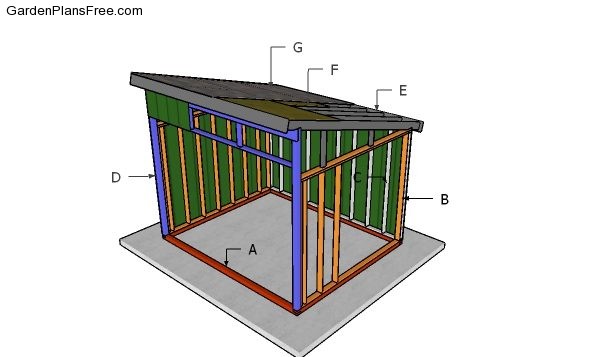
Building a 10×12 run in shed
Materials
- A – 2 pieces of 4×4 lumber – 144″ long, 2 pieces – 120″ long BASE
- B – 2 pieces of 2×4 lumber – 113″ long, 1 PIECE – 116 1/2″ long, 9 pieces – 87″ long 2xSIDE WALL
- C – 2 pieces of 2×4 lumber – 144″ long, 1 piece – 137″ long, 12 pieces – 87″ long BACK WALL
- D – 2 pieces of 4×4 lumber – 121 1/2″ long, 1 piece of 2×8 lumber – 144″ long, 1 piece of 2×4 lumber – 137″ long, 2 pieces – 15 1/4″ long FRONT WALL
- E – 10 pieces of 2×6 lumber – 144″ long RAFTERS
- F – 3 pieces of 3/4″ plywood – 48″x96″ long, 3 pieces – 48″x48″ long ROOF
- G – 160 sq ft of tar paper, 160 dq ft of asphalt shingles ROOFING
- H – 2 pieces of 2×8 lumber – 144″ long, 2 pieces of 1×8 lumber – 148 1/4″ long TRIMS
- I – 2 pieces of T1-11 siding – 24″x120″ long, 2 pieces – 48″x120″ long, 2 pieces – 48″x108″ long, 3 pieces – 48″x91 1/2″ long, 3 pieces – 24″x48″ long SIDING
- 4 pieces of 4×4 lumber – 12′
- 2 pieces of 4×4 lumber – 10′
- 5 pieces of T1-11 siding – 4’x10′
- 4 pieces of T1-11 siding – 4’x8′
- 3 pieces of 2×8 lumber – 12′
- 2 pieces of 1×8 lumber – 14′
- 5 pieces of 3/4″ plywood – 4’x8′
- 6 pieces of 2×4 lumber – 10′
- 33 pieces of 2×4 lumber – 8′
- 4 pieces of 2×4 lumber – 12′
- 10 pieces of 2×6 lumber – 12′
- 160 sq ft of tar paper, 160 dq ft of asphalt shingles
- 2 1/2″ screws
- 3 1/2″ screws
- 3″ lag screws
- 5″ lag screws
- wood glue, stain/paint
- rafter ties
Tools
- Hammer, Tape measure, Carpentry square
- Miter saw, Drill machinery, Screwdriver, Sander, Router
- Safety Gloves, Safety Glasses, Respiratory Mask
Time
- One week
10×12 Loafing Shed – Video
STEP 1:
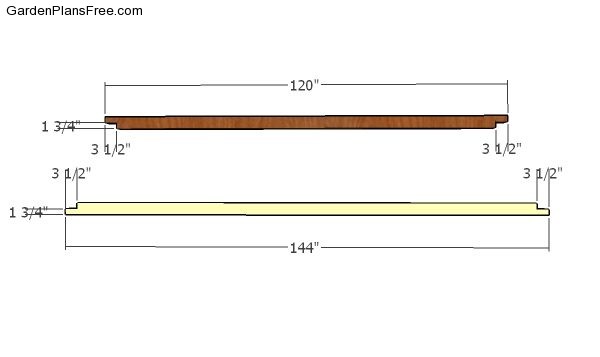
Building the skids
The first step of the project is to build the skids for the run in shed from 4×4 lumber. Use a circular saw to make parallel cuts inside the notches and then remove the excess with a chisel. Smooth the recess with sandpaper,
STEP 2:
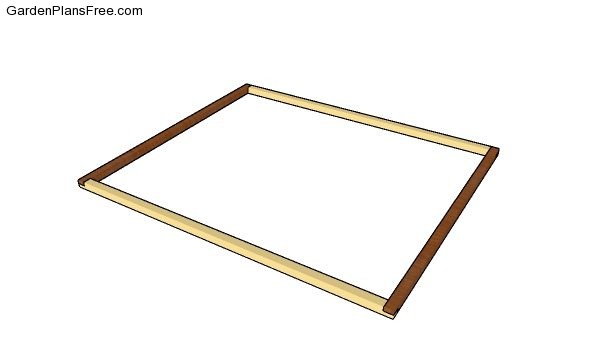
Building the base
Select the location for the run in shed. Remove the vegetation and level the ground perfectly. You can pour a concrete slab if you want a permanent construction or use gravel, if you want to move the shed in the future. Assemble the base from the pressure treated skids and make sure the corners are square. Align the edges, drill pill holes and insert 3 1/2″ screws to lock them into place tightly.
STEP 3:
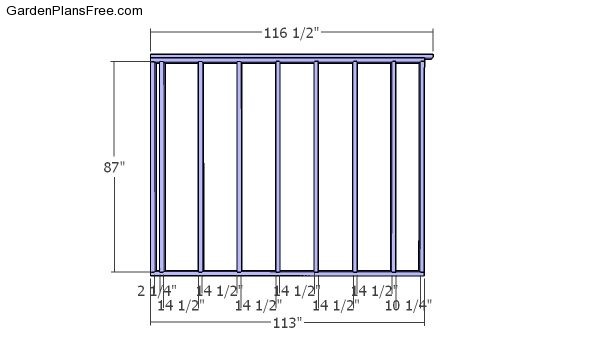
Building the side walls
Next, build the side wall for the shed from 2×4 lumber. Cut the components from 2x4s at the right dimensions. Drill pilot holes through the plates and insert 3 1/2″ screws into the studs. Make sure the corners are square and place the studs every 16″ on center.
STEP 4:

Building the back wall
Use 2×4 lumber for the back wall frame. Assemble the wall with 3 1/2″ screws.
STEP 5:
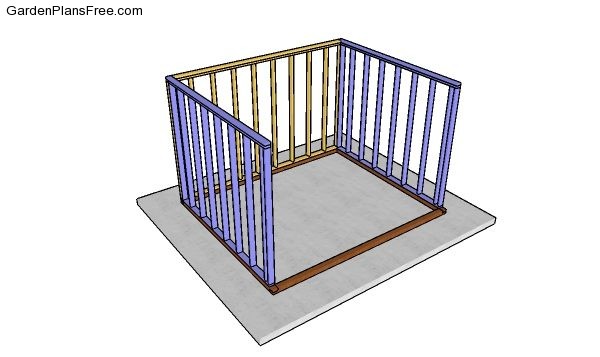
Assembling the shed frame
Fit the wall frames to the skids and plumb them with a spirit level. Drill pilot holes through the bottom plates and insert 3 1/2″ screws into the skids. Lock the adjacent walls together with 3 1/2″ screws. Make sure the corners are square.
STEP 6:

Front posts
Use 4×4 lumber for the front wall posts. Use a circular saw to make a notch to the top of the posts, so you can fit the beam.
STEP 7:
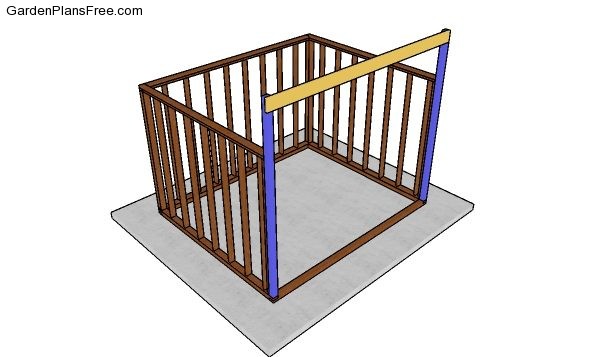
Fitting the top beam
Plumb and attach the posts to the front of the shed. Drill pilot holes and insert 5″ lag screws to lock the posts into place. Attach the 2×8 beam to the top of the posts and use 3″ lag screws to secure it into place.
STEP 8:
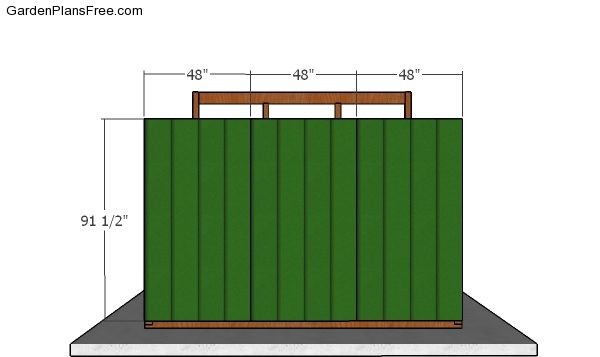
Back wall panels
Attach the 5/8 T1-11 siding sheets to the back of the shed. Align the edges flush and use 6d nails, every 8″ along the framing.
STEP 9:

Framing front top wall
Use 2×4 boards to frame the front wall. Drill pocket holes and insert 2 1/2″ screws to lock everything together tightly.
STEP 10:
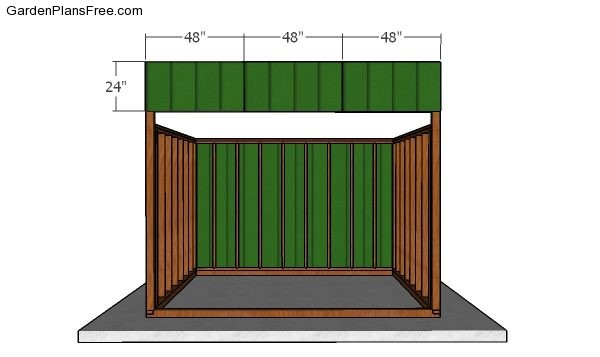
Front panels
STEP 11:

Building the rafters
Use 2×6 lumber for the rafters. Make the notches with a circular saw.
STEP 12:

Fitting the rafters
Fit the rafters to the top of the shed, every 16″ on center and secure them into place with ties.
STEP 13:
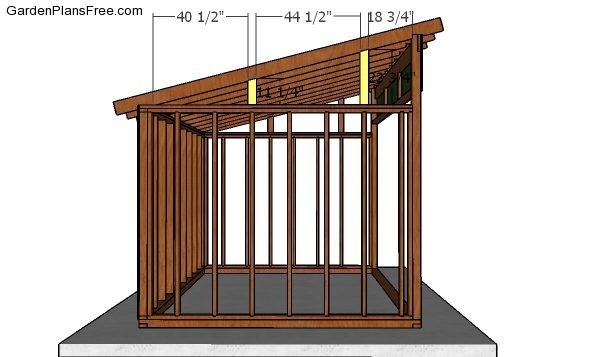
Side supports
Use 2×4 lumber for the side roof supports. Secure them to the shed frame with screws.
STEP 14:

Fitting the side panels
Attach the side siding panels with 6d nails. Leave no gaps between the sheets.
STEP 15:
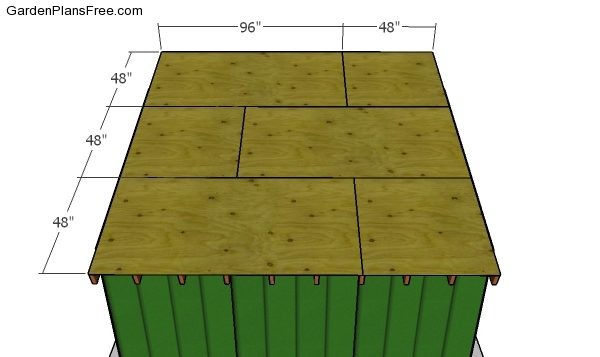
Fitting the roofing sheets
Attach the 3/4″ plywood sheets to the roof of the shed. Follow the pattern shown in the diagram and use 1 5/8″ screws. Leave no gaps between the sheets.
STEP 16:
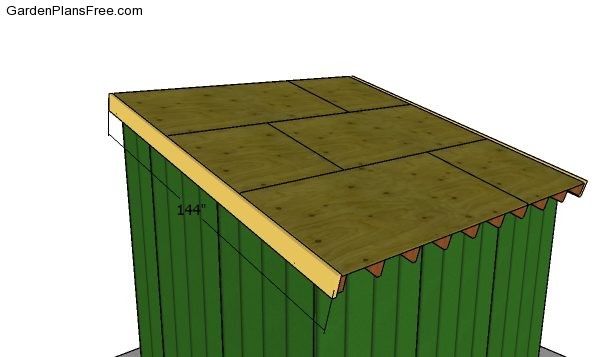
Side roof trims
Fit 2×8 trims to the sides of the shed. Align the edges and insert 3 1/2″ screws to lock them in place.
STEP 17:
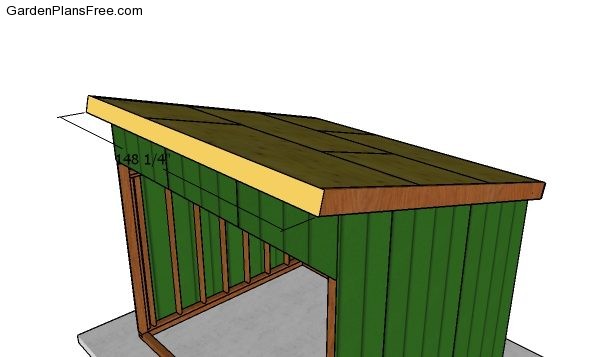
End roof trims
Fit the 1×8 trims to the front and back of the shed roof.
STEP 18:
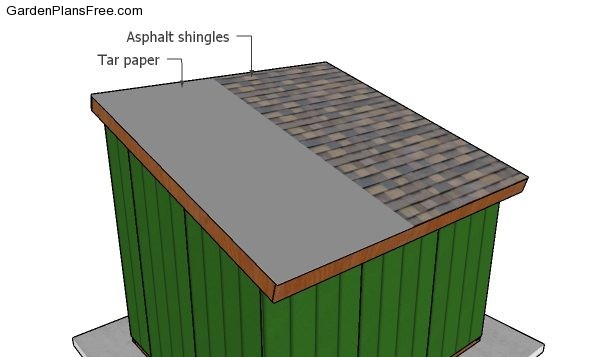
Fitting the roofing
In order to waterproof the shed, you have to cover the roofing sheets with felt. Make sure the strips of roofing felt overlap at least 2-3″ and staple them to the plywood sheets every 8″. Continue the project by installing the asphalt shingles. Place the starting course at the bottom of the roof, before fitting the rest of the shingles.
PRO TIP: Always read the manufacturer’s instructions, before installing the shingles. They provide essential information about the installation of the shingles.
STEP 19:
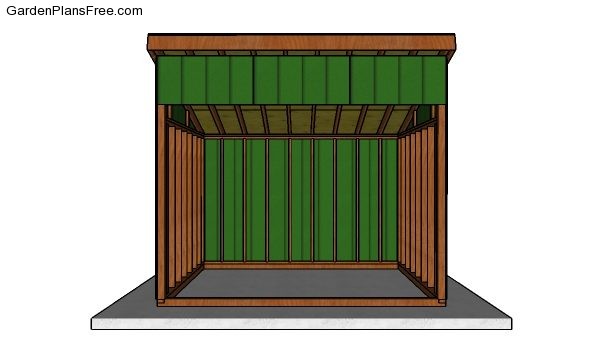
10×12 Run In Shed Plans – front view
You can now add all sorts of accessories to the shed to suit your needs.
STEP 20:
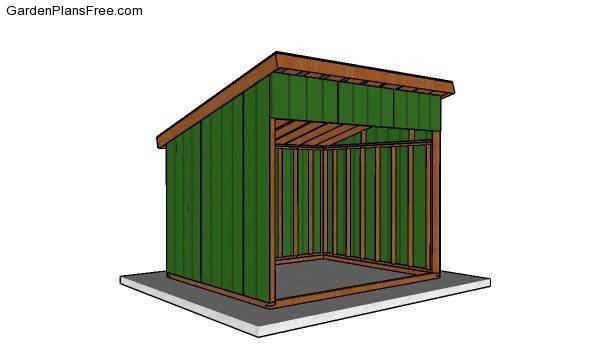
10×12 Run In Shed Plans
After installing the roof and the asphalt shingles, there are still a few finishing touches you have to take care of. First of all, you could fill the holes and gaps with wood filler and smooth the surface with medium-grit sandpaper. See plans for a small garden tool shed HERE.
This diy project was about 10×12 run in shed plans. If you have enjoyed the free project, we recommend you to share it with your friends, by using the social media widgets.

